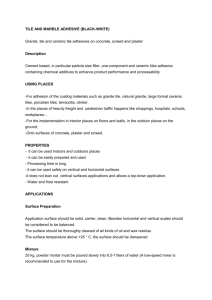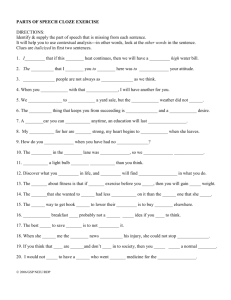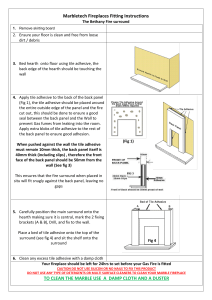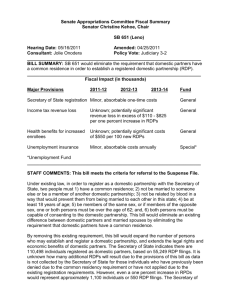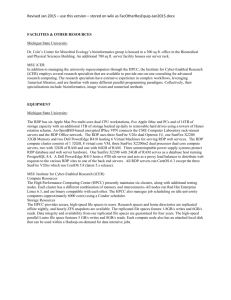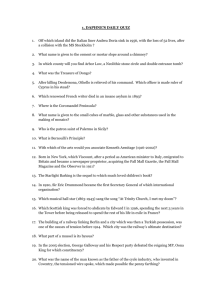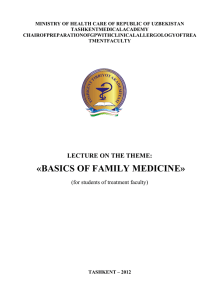tECh LINE3 Interaction of Cellulose Ethers and redispersible
advertisement
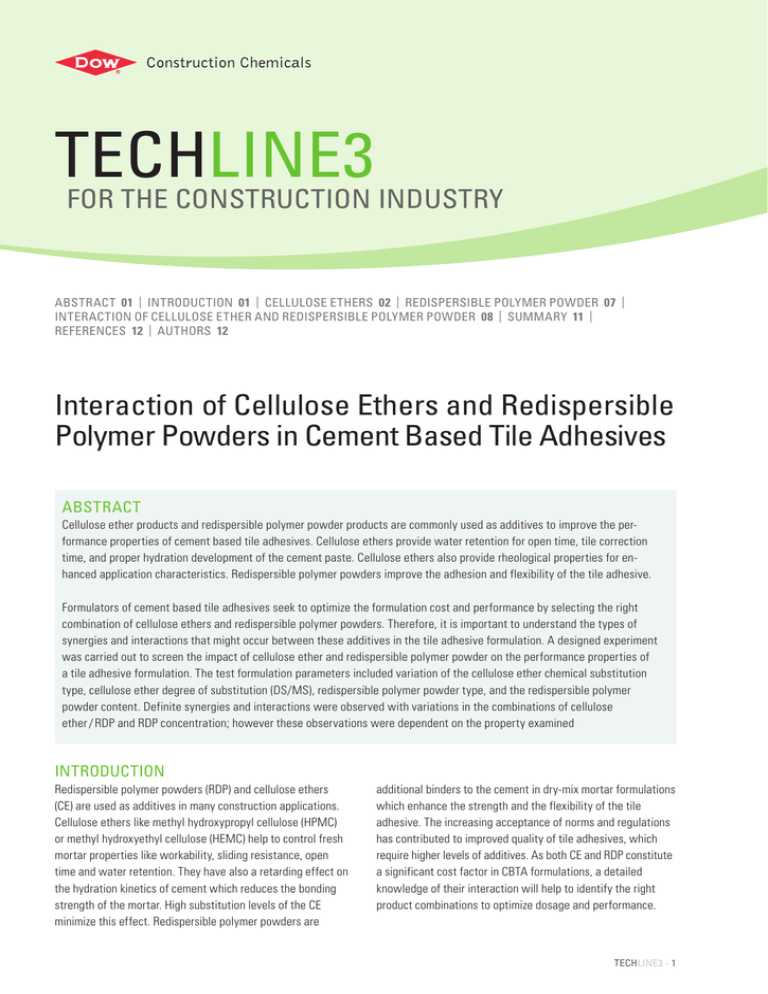
TECHLINE3 FOR THE CONSTRUCTION INDUSTRY ABSTRACT 01 | INTRODUCTION 01 | Cellulose Ethers 02 | Redispersible Polymer POWDER 07 | INTERACTION OF CELLULOSE ETHER AND REDISPERSIBLE POLYMER POWDER 08 | Summary 11 | REFERENCES 12 | Authors 12 Interaction of Cellulose Ethers and Redispersible Polymer Powders in Cement Based Tile Adhesives Abstract Cellulose ether products and redispersible polymer powder products are commonly used as additives to improve the per­ formance properties of cement based tile adhesives. Cellulose ethers provide water retention for open time, tile correction time, and proper hydration development of the cement paste. Cellulose ethers also provide rheological properties for en­­ hanced application characteristics. Redispersible polymer powders improve the adhesion and flexibility of the tile adhesive. Formulators of cement based tile adhesives seek to optimize the formulation cost and performance by selecting the right combination of cellulose ethers and redispersible polymer powders. Therefore, it is important to understand the types of synergies and interactions that might occur between these additives in the tile adhesive formulation. A designed experiment was carried out to screen the impact of cellulose ether and redispersible polymer powder on the performance properties of a tile adhesive formulation. The test formulation parameters included variation of the cellulose ether chemical substitution type, cellulose ether degree of substitution (DS/MS), redispersible polymer powder type, and the redispersible polymer powder content. Definite synergies and interactions were observed with variations in the combinations of cellulose ether / RDP and RDP concentration; however these observations were dependent on the property examined INTRODUCTION Redispersible polymer powders (RDP) and cellulose ethers (CE) are used as additives in many construction applications. Cellulose ethers like methyl hydroxypropyl cellulose (HPMC) or methyl hydroxyethyl cellulose (HEMC) help to control fresh mortar properties like workability, sliding resistance, open time and water retention. They have also a retarding effect on the hydration kinetics of cement which reduces the bonding strength of the mortar. High substitution levels of the CE minimize this effect. Redispersible polymer powders are additional binders to the cement in dry-mix mortar formulations which enhance the strength and the flexibility of the tile adhesive. The increasing acceptance of norms and regulations has contributed to improved quality of tile adhesives, which require higher levels of additives. As both CE and RDP constitute a significant cost factor in CBTA formulations, a detailed knowledge of their interaction will help to identify the right product combinations to optimize dosage and performance. TECHLINE3 - 1 1.5% viscosity [Pa.s] Before investigating potential interactions of CE and RDP it is important to understand the individual roles of these additives. Many of the performance tests have been run according to European Norm EN 12004. However, our experience shows that the trend of test results with structural parameters of the additives correlates well with ANSI standards. The qualitative results of these studies are therefore also valid for North American conditions. CELLuLoSE EthErS Cellulose ethers (HPMC and HEMC) are available in different molecular weights and substitution levels. The following data have been generated based on a range of various commercially available cellulose ethers. Their structural properties were analyzed and they were all tested according to EN 12004 in the following standard tile adhesive formulation: Portland Cement CEM I 42.5 40.00 pbw Quartz Sand (0.1 – 0.3 mm) 60.00 pbw Cellulose Ether 0.35 pbw Starch Ether 0.08 pbw rDP 0.50 pbw Water 24.00 pbw weight average molecular weight Figure 1: Plot of CE viscosity in Pa�s (1.5% aqueous solution at a share rate of 2.0 s-1) against weight-average molecular weight The aqueous viscosity of the cellulose ether has an important influence on the rheology of the tile adhesive formulation. The rheology of mortars can be reliably measured with a Brookfield RVT rheometer equipped with a T-spindle and Helipath. In order to understand the impact of additives on CBTA formulations, both the raw mortar properties as well as the final adhesive strength properties have to be considered. They are largely interrelated. Some of the raw mortar properties can even be correlated with the rheology of the aqueous solutions of CE. The predominant factor controlling the viscosity of CE solutions in water is the molecular weight of the linear polymer. The weight-average molecular weight of the cellulose ethers Mw has been determined by gel permeation chromatography. Plotting the molecular weight against the viscosity of a 1.5% aqueous solution gives a linear relationship (see figure 1). 2 - tEChLINE3 BF visco 5.0 rpm Table 1: Standard tile Adhesive Formulation 1.5% viscosity Figure 2: Plot of mortar consistency (as Brookfield viscosity at 5.0 rpm) against aqueous viscosity of the cellulose ether Control of the substitution levels of both substituents in HEMC and HPMC products allows for adjustment of the surface activity of cellulose ethers. The higher the surface activity of the cellulose ether, the more air will be entrapped during the preparation of the cementitious tile adhesive reducing its fresh mortar density. BS after 20 min. OT [N/mm2] mortar density (kg/l) In order to achieve the same rheology and water retention, high viscous cellulose ethers can be used at a lower addition level; thus saving formulation cost. The viscosity of the cellulose does not only affect the raw mortar properties of the adhesive; it can also have a strong impact on the final strength proper ties. Reducing the viscosity of the CE has a positive effect on the open time of the tile adhesive as a function of bond strength. surface tension 1% [dyn/cm] 1.5% viscosity Figure 5: Fresh mortar density as a function of CE surface tension Figure 3: bonding strength after 20min open time as a function of CE viscosity BS after 20 min. OT [N/mm2] BS after water aging The reason for this is enhanced wetting capabilities of cellulose ethers with lower molecular weight at the same dosage level. Larger tile surface coverage of the adhesive results in higher bonding strength. Low mortar density is beneficial for the workability of the adhesive; thus, requiring less force to spread the mortar. Mortar density has also a strong impact on the strength properties; particularly after the wet aging step. The reason for this relationship will be explained later. mortar density (kg/l) Mw Figure 4: Surface coverage (wetting) as a function of CE weight-average molecular weight Figure 6: Plot of bonding strength after wet aging against fresh mortar density tEChLINE3 - 3 Cellulose ether with a weak surface activity will contribute to higher mortar density and improve bond strength. This trend, however, is in conflict with the need for easy workability, which requires low fresh mortar densities. Low fresh mortar density contributes to lower bond strength; particularly after the open time test. In order to find out if the lower mortar densities also result in higher evaporation rates (drying out of the mortar at a faster rate), we have compared the water loss with time of four different CBTA formulations. Figure 8: Schematic cross section of an applied tile adhesive ridge Water Content [%] After a period of time, the tile is placed in the mortar bed and a weight is applied. The initial contact of the tile to the adhesive is at the top edge of the ridges. The skin prevents the adhesive from wetting the tile. After the weight is applied, the wet adhesive from the center of the ridges squeezes out at the sides, and wets the tile between the initial ridges. Open Time [min] Figure 7: Water loss of tile adhesive formulations with time Within the accuracy of the experiment, the water loss is independent from the fresh mortar density. The water loss seems to be more pronounced during the first five minutes after the adhesive has been applied. It slows down during the next ten minutes, and starts to become more pronounced again after 15 minutes. This is in line with a mechanism proposed by Jenni et al. . The explanation for this behavior could be that water evaporates quickly on the surface of the CBTA ridges. A thin CE film forms after 5 minutes, preventing further evaporation. More water migrates from the center of the ridges, partially dissolves the initial film, and eventually evaporates. The water flux also transports additional CE to the surface of the tile adhesive where it enriches with time, forming a more solid skin. This skin will not dissolve anymore; thus preventing the adhesive from wetting the tile. 4 - tEChLINE3 Figure 9: Photograph of tile breaking pattern after open time The picture above illustrates the breaking pattern after the tile is pulled off after 28 days. There is cohesive failure (breakage within the adhesive) only in the space between the ridges. The mechanism of skin formation is still subject to internal research. The degree of substitution (DS) of methyl groups has a strong influence on the kinetics of cement setting. Temperature [deg C] It was confirmed that sucrose acts via nucleation poisoning/ surface adsorption. The same effect was demonstrated on the polymer as well. H.J. Weyer et al. have monitored the cement hydration with the help of synchrotron radiation in-situ in the presence of cellulose ethers. They found out that the level of methylation has a significant effect on the hydrolysis of the C2S/C3S phases. With increasing methyl-substitution, the anhydroglucose unit of the cellulose ether becomes more hydrophobic, adsorbs less on the clinker phase surface, and consequently has less retardation effect (see figure 11). time [hours] A strong retardation effect on the cement setting enables the water to evaporate and dry out the adhesive before the cement can completely hydrate; thus, we observe lower strength properties of the adhesive (figure 12) with low methyl DS. Figure 10 shows the temperature development of cement setting in the presence of various types of cellulose ethers. The three curves with temperature peaks at 7 hours (see arrow) represent samples without cellulose ether. Plotting the delay of the cement setting against the degree of methyl substitution DS reveals a linear relationship. bonding strength [N/mm2] Figure 10: Adiabatic temperature development of cement setting in the presence of various cellulose ethers delay time [hours] Methyl DS Figure 12: CBtA bonding strength as a function of methyl degree of substitution Methyl DS The cement setting will resume once the adhesive contacts water. The bonding strength after the water aging step is at a higher level, and almost independent from the methyl DS, as can be seen in figure 13. This effect is more pronounced in formulations containing CE with low methyl DS. Figure 11: Cement setting delay time plotted against methyl substitution level It has been shown that sucrose and other glucose derivatives accelerate ettringite formation, but are more effective at retarding C3S (tri-calcium silicate) phase hydration. tEChLINE3 - 5 bond strength [N/mm2] 1% RDP Methyl DS Figure 13: CBtA bonding strength after various aging steps as a function of methyl substitution level The bond strength after open time is usually weaker and follows a different mechanism as described earlier. Upon heat aging at 70ºC, the adhesive is subject to thermal stress at the tile/adhesive interface. This reduces the bond strength significantly. The addition of RDP helps to make the adhesive more flexible, and improves the bond strength. Depending on the dosage level of the polymer powder, the cohesive strength is improved because the interface between tile and adhesive gets stronger. Adding more RDP to the tile adhesive formulation causes the adhesive to break within the cement matrix and not at the interface as illustrated in figure 14. The breaking pattern of the tile after the heat aging test is shown at 1%, 3% and 5% addition level of a redispersible polymer powder. 3% RDP 5% RDP Figure 14: Breaking pattern of tiles after the heat aging test with various amounts of rDP 6 - tEChLINE3 Liquid polymer dispersions can be spray-dried and used as a powder component in dry-mix mortar formulations. When mixed with water, the powder redisperses and forms films in the cement matrix, which further enhance the strength properties of cementitious mortars. Vinylacetate/Ethylene copolymers are the preferred polymers in the market for producing redispersible polymer powders. We have compared two RDP products in a CBTA formulation at two different dosage levels. Composition tg [ºC] MFFt [ºC] Polymer 1 Vinylacetate/Ethylene 6 0 Polymer 2 Vinylacetate/Ethylene 17 3 share bond strength [psi] rEDISPErSIBLE PoLYMEr PoWDEr Table 2: CBtA Formulation Polymer 2 has a higher glass transition temperature compared to Polymer 1. The adhesives have been tested according to some of the shear bond specifications of ANSI A118.4 and A118.11 in the following formulations: Component unit Formulation 1 Formulation 2 Cement pbw 40.0 40.0 Sand pbw 56.7 54.7 rDP pbw 2.0 4.0 hPMC pbw 0.3 0.3 Water pbw 24.0 24.0 Table 3: ANSI A118.4 / A118.11 Formulations Figure 15: ANSI A118.4 – 5.0 Shear Strength to Impervious Ceramic Mosaic tile (vitreous tile) The shear bond strength of two impervious ceramic mosaic tiles (low absorption vitreous tiles) after various aging periods is illustrated in figure 15. The shear bond strength after 7 days is the case of 2% RDP dosage level, specific to this evaluation, higher compared to the 28 days. The reason for this is still unknown to us. When comparing the shear bond strength after 28 days for the five formulations, it becomes obvious that that the use of RDP in the formulation improves the strength properties of the adhesive. The harder polymer (Polymer 2) provides higher strength. After the test specimens have been immersed in water for 7 days, the shear bond strengths decrease to the level observed for the mortar without polymer powder. In formulations with 4% RDP the drop in strength is even more pronounced. The water immersion step seems to completely reduce the contribution of the RDP to the mortar strength. tEChLINE3 - 7 share bond strength [psi] The base formulation was: Quartz Sand (0.1 – 0.3 mm) 60.00 pbw Portland Cement CEM I 42.5 40.00 pbw Cellulose Ether 0.35 pbw Water 26.00 pbw Three independent variables: Variable Parameters CE Chemistry rDP dosage rDP grade Figure 16: Shear bond 4”x 4” Quarry/Wood When quarry tile / plywood composites are tested for shear bond strength, the impact of the polymer becomes more pronounced, as illustrated in figure 16. Adding 2% of polymer 1 to the formulation doubles the strength of the adhesive. With 4% of polymer 2 the strength is almost four times the value of the adhesive without polymer powder. An increase in bond strength is also observed between formulations containing polymer 1 and polymer 2; most likely due to the higher glass transition temperature of polymer 2. INtErACtIoN oF CELLuLoSE EthEr AND rEDISPErSIBLE PoLYMEr PoWDEr Formulators of cement based tile adhesive try to optimize the cost/performance ratio by selecting the right combination of cellulose ethers and redispersible polymer powders. The understanding of synergistic effects or incompatibilities between these additives is critical. We have used an experimental design to screen the impact of CE and RDP in a CBTA application and to identify potential interactions. hEMC hPMC 1% 3% 5% rDP1 rDP2 rDP3 Both cellulose ethers have an aqueous viscosity of 35,000 mPa*s (2% aqueous solution, at 20 rpm Brookfield RVT, spindle 4, 23ºC) Variable CE Chemistry Parameters hEMC hPMC DS Meo 1.6 1.8 MS hPo/hEo 0.27 0.15 The RDP grades represent: rDP1 Vinylacetate/ethylene copolymer with neutral rheology rDP2 Vinylacetate/ethylene/VeoVa* terpolymer with neutral rheology rDP3 Vinylacetate/VeoVa* copolymer with thickening effect Fresh mortar density is an important parameter affecting the strength properties of cement based tile adhesives. Both the type of CE and the type and dosage of the RDP play an important role for the density of the mortar. Figure 17 illustrates the possible combinations and their effect on mortar density. * VeoVa = vinyl ester of versatic acid (a synthetic, highly branched-C10 tertiary carboxylic acid) 8 - tEChLINE3 1 2 3 4 Figure 18: Fresh mortar density, consistency and sliding resistance as a function of CE type and rDP type and amount at 3% rDP dosage Figure 17: Combinations of CE and rDP and their effect on fresh mortar density Figure 17 shows a matrix of some of the possible combinations of CE and RDP in the adhesive and their effect on mortar density. When switching from the HEMC to the HPMC (case 1 to case 2) in the presence of RDP 1, the density slightly increases due to the lower surface activity of the HPMC. RDP 2, however, has a strong interfacial activity as well, and decreases the density due to more effective air entrainment (case 3). The strong surface activity of RDP 2 masks the effect of the cellulose ether. In the three first cases, the amount of RDP has a negative effect on the mortar density. However, when using RDP 3 this trend is reversed. RDP 3 has a defoaming and thickening effect. This property needs to be considered when it is used in combination with strongly modified cellulose ethers. The main effects of redispersible polymer powder in tile adhesive formulations are to increase bond strength and flexibility. The right combination of CE and RDP is critical in optimizing the cost/performance ratio. The following test results (figure 19) were obtained in accordance with EN 12004 test methods. 1 2 3 Fresh mortar density and mortar consistency typically show the same trend if no additional thickeners are present. The increase in mortar density and consistency has also a positive effect on the tile sliding resistance as figure 18 illustrates. High consistency of the adhesive mortar typically results in less sliding of the tile on a vertical substrate. 4 Figure 19: Bond strength as a function of combinations of CE and rDP at 3% rDP dosage tEChLINE3 - 9 Using HEMC in combination with RDP 1 gives less bond strength compared to the HPMC (case 1 and case 2). The reason for higher strength is the higher methyl DS of the HPMC, which has less impact on the cement retardation (see figure 12: CBTA bonding strength as a function of methyl degree of substitution). When using RDP 2, the bond strength slightly improves (case 3). This polymer powder also compensates for the decreased bond strength caused by the retarded cement setting of the low substituted HEMC. The adhesive strength is independent from the selected cellulose in case 3 and case 4 (RDP 3). The measured bond strength is composed of two noted contributors: cement matrix and polymer film. The right choice of the cellulose ether allows for optimization of the cement matrix strength. If the polymer film is strong enough, it can compensate for poor CE performance (RDP 2 and RDP3). Standard CBTA products contain lower levels of RDP; just enough to pass the standards for the bond strength after heat aging. The cellulose ether effect on the cement dominates the bond strength of the adhesive (see figure 20). Figure 21: Bonding strength after 20 min open time Increasing the amount of RDP improves the bond strength after open time in all cases. RDP 2 is the most effective product in high performance tile adhesives (RDP dosage > 3%) for improving the bond strength after 20 minutes of open time as illustrated in figure 21. Standard RDP products based on VA/E co-polymers do not help to improve bond strength after water immersion (wet aging). The polymer film swells and looses all strength properties in the wet state. The measured strength is only based on the contribution of the cement matrix. The presence of a hydrophobic monomer like VeoVa in the polymer backbone has a positive effect on the hydrolytic stability of such CBTA products (figure 22). Figure 20: Bonding strength at low rDP dosage At an RDP addition level of 1.0% (or lower) the cement component of the overall strength property prevails, which makes the highly substituted HPMC the CE of choice in combination with RDP 1. Bond strength after open time is an important performance criterion for CBTA products. Within the scope of the described experimental design, the bond strength after open time can only be controlled by the type and dosage of the polymer powder. 10 - tEChLINE3 Figure 22: Bonding strength after water immersion using different types of rDP SuMMArY The difference in composition of RDP 1, 2 and 3 were listed earlier. Their content of VeoVa co-monomer is 0%, 20% and 40%, respectively. To resist wet aging the content of this hydrophobic co-monomer is critical. The impact of the CE is insignificant. When using RDP 1, the bond strength after water immersion even slightly decreases with increasing addition levels. Using RDP 2 in place of RDP 1 reverses this trend, enhancing the hydrolytic stability of the CBTA formulation. RDP 3 (VA/VeoVa copolymer 60:40) provides further enhancement of the hydrolytic stability of CBTA’s. To pass the heat aging test, the composition of the RDP is of minor importance. The main contributor to the bond strength of the adhesive is addition level of RDP (figure 23). Figure 23: Bonding strength after heat aging at 70ºC The HPMC provides slightly higher bond strength compared to the HEMC. Cellulose ethers and redispersible polymer powders are key performance additives in cement based tile adhesives. They both determine fresh mortar properties as well as the final strength of the mortar. We were able to demonstrate that the detailed understanding of the individual roles of these components can be successfully used to optimize the performance of CBTA formulations. The impact of the cellulose ether on the performance of tile adhesives is based on their rheological characteristics and on the retardation of the cement setting kinetics. Many of the effects caused by their molecular structure are in conflict with each other. The thickening effect of cellulose ethers is strongly related to their molecular weight. High viscous cellulose ethers have a high water demand, but they also reduce sliding resistance and limit open time. The surface activity of CE is determined by the substitution pattern. Highly surface-active grades incorporate more air during the mixing process of the CBTA; thus, reducing the fresh mortar density. This effect is beneficial to the workability of the mortar. However, the strength properties of the adhesive are negatively affected. The cement retardation can be linearly correlated with the methyl degree of substitution of the CE. CE with higher methyl DS will retard the cement setting to a lesser extent, resulting in higher bond strength. The use of redispersible polymer powders in CBTA formulations, enhance the strength of the adhesive mortar. VA/E copolymer based RDP’s have a different effect on the bond strength depending on their hardness, as indicative of the Tg. A higher glass transition temperature of the polymer results in superior strength properties. VA/E based polymer powders do not help to improve bond strength per the water immersion test. The presence of a hydrophobic co-monomer like VeoVa is required to improve the hydrolytic stability of the tile adhesive. Experimental design is a very useful tool to screen the impact of additives in complex formulations. Interactions of CE’s and RDP’s in CBTA formulations were observed, which can be applied synergistically to improve the cost/performance ratio. In standard tile adhesives with low RDP levels, the mortar strength properties are largely influenced by the cement retardation effect of the CE. Products with high methyl DS will give superior strength properties. High performance tile adhesive contain higher levels of RDP (3%– 5%) to meet the requirements for extended bond and flexural strength. High performing RDP products can compensate the negative effect of CE on the cement setting. tEChLINE3 - 11 AuthorS Robert Baumann, Ken Tarantul, Cindy Powell, Andreas Wichmann, Christa Tepper, Marga Perello, Mark van Heeringen, Wolfgang Koch, Phil Griggs, Michael Radler / The Dow Chemical Company REFERENCES 1.A . Jenni, L. Holzer, R. Zurbriggen, M. Herwegh “Influence of polymers on microstructure and adhesive strength of cementitious tile adhesive mortars” Cement and Concrete Research 35 (2005) 35– 50 2.Bishop, Maximilienne; Barron, Andrew R. “Cement Hydration Inhibition with Sucrose, Tartaric Acid, and Lignosulfonate: Analytical and Spectroscopic Study”; Industrial & Engineering Chemistry Research (2006), 45(21), 7042-7049 3.H.J. Weyer, I. Müller, B. Schmitt, D. Bosbach, A. Putnis, “Time-resolved monitoring of cement hydration: influence of cellulose ethers on reaction kinetics“; I. Nucl. Instr. and Meth. in Phys. Res. B 238 (2005) 102-106 For more information please send your email to dccinfo@dow.com or consult our web site www.dowcc.eu 840-01201-032011
